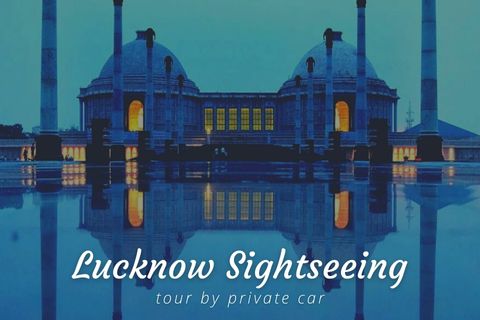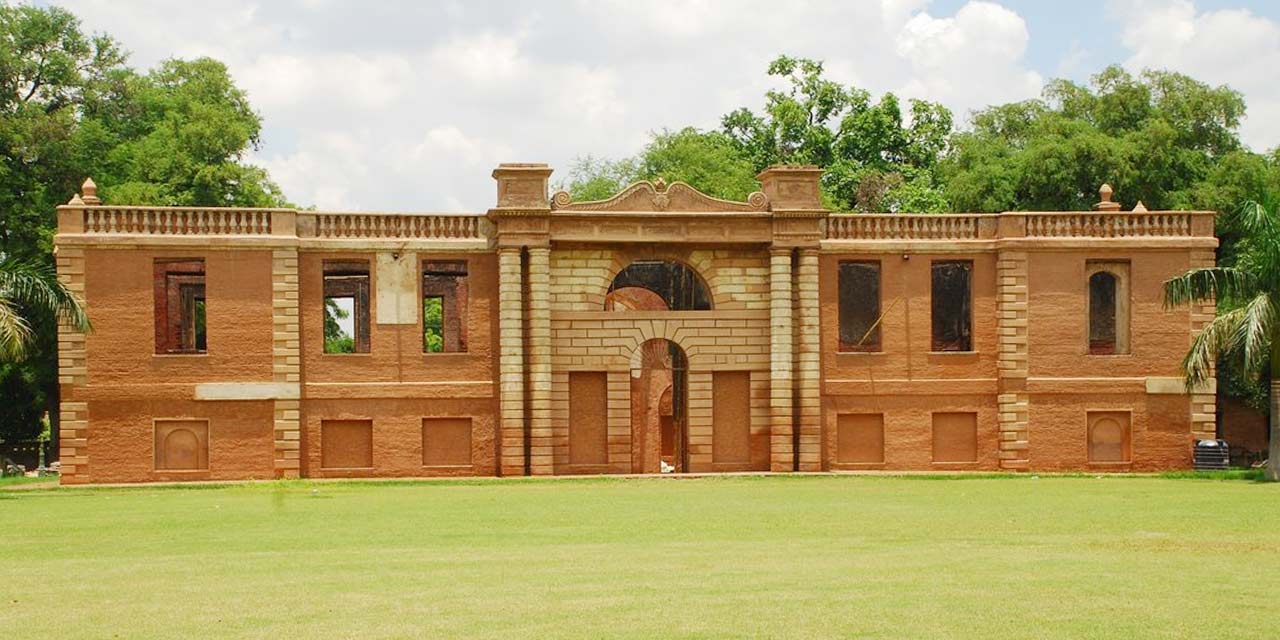Dilkusha Kothi Palace Lucknow Entry Fee
- 5 per person for Indians
- 100 per person for Foreign Tourists
Dilkusha Kothi Palace Lucknow Phone
05222 307037
Rating:  | 4/5 stars
| 4/5 stars
Based on total 63 reviews
Dilkusha Kothi Palace Lucknow Address: Bibiapur Marg, Neil Lines, Cantonment, Lucknow, Uttar Pradesh, 226002, India
If there is one thing that Lucknow stands out for, it is its regal and royal aura. There is a touch of richness from the monuments to the cuisine.
The magnificent and extraordinary Dilkusha Palace is located in the cantonment area of Lucknow, to the northeast of Raj Bhavan.
You can see the ruins of a mansion constructed in the English baroque style in the eighteenth century near Dilkusha Kothi. Even though it is now in ruins, the remnants are a clear testament to its erstwhile artistic beauty and excellent architecture.
It still has a regal air to show it is a building with a lot of historical and cultural value. Some of the most exciting moments in Indian history have taken place there. It is one of Lucknow's lesser-known historical sites and one of the top tourist attractions of Lucknow.
#Trivia: Dilkusha Kothi, often referred to as the English house or Vilayati Kothi, was constructed during the rule of Nawab Saadat Ali Khan.
Architecture of Dilkusha Kothi
One of Lucknow's most magnificent monuments, the Dilkusha Kothi, is built in the Baroque architectural style. It is close to the Lucknow cantonment area in the NER colony.
You'll observe that the building lacks a courtyard, which is strange because that was quite uncommon during those times. Additionally, the Delaval Hall of Seaton bears a striking resemblance to the design.
The Dilkusha Kothi's main structure is located on the western section of the north-south axis. This was made specifically for the Nawab. It was a palace that the Nawab held dear, which is why it was given the name "Dil Kusha," which translates to "happy heart."
#Trivia: William Howard Russell, a renowned Times journalist, reported that Lucknow was the most beautiful City he had ever seen and that it was more lovely than Rome, Athens, and Constantinople.
It is built on a higher platform facing west, which can only be comprehended by looking at the bastions surrounding it. Additionally, the ruins show that the guard room was one of a series of small chambers on one side.
The building's roof was entirely demolished during the conflict in 1857, further damaging the eastern side and ruining the brilliant architectural design. The Palace has been repaired, thanks to the Government and the Archeological Survey of India.
#Trivia: Mary Linley Taylor, a British actress who lives in Seoul, South Korea's Jongno neighborhood, decided to name her home "Dilkusha" after her visit to the Dilkusha Kothi.
Another mansion with outstanding architecture and an Indo-European design is located northeast of this structure. The two-story castle is constructed with lime mortar and Lakhauri bricks.
It looks gorgeous with the white plaster all over it. Given that the location was enveloped with thick jungles and deadly wild animals, the palaces served as hunting lodges and vacation resorts.
Image Gallery of Dilkusha Kothi Palace Lucknow
History behind Dilkusha Kothi
Major Gore Ouseley, a British resident and close friend of Nawab Saadat Ali Khan, the then-ruler of Oudh, created the Dilkusha Kothi in the 18th century. Although it also operated as a summer resort, it was initially constructed as a hunting lodge for the Nawabs.
The Dilkusha Kothi, now one of the top sightseeing spots in Lucknow, was once utilized by the Begums (wives of Nawabs) as a location to unwind, rest, and take picnics because of its proximity to the river. This location lacked a separate zenana (women's room), a characteristic of all Nawabi structures, which is noteworthy.
The structure underwent additional modifications during the reign of Nawab Wajid Ali Shah. He was the tenth and last Nawab of Awadh. During the early years of his administration, he was the one who constructed another Kothi just next to it. He did this so that he could organize military drills for his soldiers.
The British, extremely upset by this act, commanded him to cease all further drills. The Nawab felt pretty upset and helpless as a result. He was compelled to resign by the British not long after that. He was unlawfully removed from office due to his refusal to sign his abdication statement before doing so.
But during the siege of Lucknow, the Palace was destroyed, and gunshot holes could be seen on every wall, a loud reminder of the courageous freedom fighters' sacrifice. With the aid of British troops, Sir Colin Campbell, the Commander-in-Chief at the time, seized control of the Palace in November 1857.
How Dilkusha Kothi stands today
The structure suffered considerably after the siege of Lucknow in 1857 and was destroyed by the 1880s. The Indian Archaeological Survey has been working on its restoration for several years.
In the current situation, Dilkusha Kothi is a destroyed palace surrounded by large yet constrained Dilkusha Gardens. The large gardens are still present, although the monument consists of a few towers and external walls. In addition, a magnificent mansion northeast of this structure was constructed in the Indo-European style.
Even if there aren't many people around in the summer, things are very different in the winter. Numerous tourists from various countries travel there to visit the location. Many people, including children and teenagers, view this as a great picnic location where they spend the entire day with friends and family.
This location is surrounded by history, nature, and peace and is ideal for reflective conversations. Despite being close to the busy Charbagh railway station, this location is serene, especially in the winter.
You can't help but be moved by the sight of the Dilkusha Kothi and the events that took place here when you see it now. It appears as though the building is lamenting the sacrifices and lives lost. The air is heavy with nothingness, and nostalgia overtakes you in the midst of it all.
Entry fee and timings of Dilkusha Kothi
The entry fee for Indian visitors is Rs. 5 and Rs.100 for international tourists. It is open daily from 8 am to 6 pm.
#Trivia: Dilkusha Kothi is fairly large, so allow at least an hour to complete your visit and click some amazing photographs.
Best time to visit Dilkusha Kothi
The soothing weather conditions during the winter season in Lucknow welcome hordes of tourists every year to Dilkusha Kothi The mildly chilly nights and fresh wind during the day make perfect conditions for exploring the lovely City.
#Trivia: Pack some warm clothing to keep you comfortable on chilly nights.
The heat waves that frequently strike this area throughout the summer make it uncomfortable to travel through the City. The same is true of rainy days, where unexpected downpours might ruin your daily schedule, and the humidity will not allow you to step out.
Schedule your trip during the pleasant winter months of October to March to experience Lucknow at its best.
How to reach Dilkusha Kothi?
Lucknow has a good transportation network that includes aircraft, trains, and buses that connect it to other regions of the nation. Numerous planes connect the city with different regions of the world through Lucknow Airport in Amausi.
Train travelers can reserve their seats up till Lucknow's Charbagh railway station. One can also take state and private buses from neighboring cities and towns to Lucknow.
By air: The Chaudhary Charan Singh International Airport in Amausi, also known as Lucknow Airport, is located approximately 15 kilometers from the City's center and connects it to all the main Indian cities. Travelers can use pre-paid taxis, cabs outside the airport, or bus service to get anywhere in Lucknow.
By train: The large rail network links Lucknow with the rest of the country through the Charbagh Railway Station in the city's center. Regular trains are available from New Delhi, Kolkata, Patna, Kolkata, and Chennai to Lucknow.
By bus: It's also a fantastic alternative to going from nearby cities to Lucknow by car. Numerous deluxe, luxury, Volvo, and state buses are frequently available for Lucknow.
Once you are in Lucknow, the several commutes available throughout the City make traveling easy. From booking a private taxi from top car rental companies in Lucknow to boarding a local auto, you can reach Dilkusha Kothi easily.
Lucknow is brimming with modern architecture and places to unwind with friends and family. Dilkusha Kothi is one such top tourist attraction of Lucknow that welcomes tourists from across the country to experience history.
It is incredible to consider how much history has transpired in front of these ancient walls and how much these walls have heard or witnessed, from Nawabs to modern-day tourists. They have seen the development of the location's shape and magnificence from nothing to now. So, book a Lucknow tour package with Lucknow Tourism, a division of Holidays DNA and take a quick hour stop to roam through the Dilkusha ruins and soak in the era bygone. To get in touch with us, please fill the Contact Us form.




